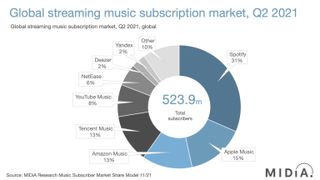Spotify vs Apple Music vs Tidal — Who pays artists more?
We asked an independent musician how well Spotify pays

The conversation of Spotify vs Apple Music (and even Tidal), which was seemingly settled, has arisen out of the ashes of Neil Young's Spotify streams. Everyone, even my dad, has been reaching out to ask about the best options for streaming music. Who could have predicted that Neil Young declaring war on Spotify and Joe Rogan would have had such an effect?
And since morals and streaming music are now mixing, it's never been a better time to look into how these services compensate the musicians whose work they offer up by the bucket. Spotify's long had a bad reputation in this capacity, but I thought people might want to hear about how it actually compares to Apple and Tidal.
So, I found the available numbers and even talked to an independent musician I know to see what things look like from their vantage.
Apple pays more per spin than Spotify, and so does Tidal
Apple, as reported by The Wall Street Journal, announced that it pays artists a mere penny per stream, and (as stingy as that sounds) that's actually good — comparatively speaking. That's because Spotify is known to pay artists "somewhere between $.003 and $.005," according to Business Insider.
But since that data comes from 2021, and was already known, I dug a little deeper, getting on the proverbial horn with one of my favorite independent musicians: Foxanne — or as anyone who works with her at our sister-site Space.com calls her, Chelsea Gohd.

Gohd, who's got music on all the major platforms including Spotify, talked to me on the office Slack, confirmed that "Apple Music pays quite a bit more than Spotify," before adding "Tidal [pays] better than Apple." She also noted that "there are a few smaller platforms that pay more but they’re much smaller."
And as for Jeff Bezos' digital jukebox? It's complicated. Gohd said "Amazon Music pays less than Apple, but still more than Spotify," before noting that the payments aren't always the same, as "sometimes Amazon has paid less than Spotify."
Sign up to get the BEST of Tom’s Guide direct to your inbox.
Upgrade your life with a daily dose of the biggest tech news, lifestyle hacks and our curated analysis. Be the first to know about cutting-edge gadgets and the hottest deals.
Spotify's rate is (clearly) not the best perk
I also wanted to know about the experience of being an artist on Spotify, and Gohd explained one reason why people would stick with Spotify despite its low rate. "Spotify’s main draw for me an an artist," she said, "is certainly not the pay, but its Spotify for Artists platform."
This set of tools, Gohd explained, "allow you to pretty easily apply to editorial playlists with new music. She then noted, "not that those are easy to get onto."
Spotify for Artists also enables musicians to "add fundraising goals to your Spotify page, links out from Spotify, add your own bio, and other materials you would have in an EPK [electronic press kit, a digital resume for musicians]."
"but between playlists and just sheer popularity yeah, Spotify is definitely where the most people listen to my music."
— Chelsea Gohd, aka Foxanne
Gohd also told me that Spotify provides "videos and articles helping new artists figure out what to do, including details on how to promote and release new music."
All of the conversation about Spotify alternatives has definitely made Gohd think twice, as she tells me "While I’m super familiar with Spotify’s features as an artist because it’s been essentially the industry standard, I haven’t yet fully explored what platforms like Apple Music and Tidal have to offer."
The other reason musicians stay on Spotify
Spotify also keeps musicians because it has the largest audience, with 209 million active free users and 172 million premium subscribers (as of its Q3 2021 earnings published on Oct. 27, 2021).
Apple isn't as transparent about its subscriber numbers, so we can only point to analysis that it likely has slightly less than Spotify (at least last year). That same analysis had Amazon Music slightly under Apple Music, with Tidal not even registering, stuck in the 10% of the chart known as "Other."

Gohd confirmed that her own experience matches this, saying "From the analytics I’ve seen, Spotify is definitely where most people listen to my music, though it seems that Bandcamp," (here's her Bandcamp page) an independent music service that's also in the 10% "Other" section, "is actually also very popular among my listeners specifically - and I think that’s true for a lot of indie artists because listeners want to proactively support artists they like ... but between playlists and just sheer popularity yeah, Spotify is definitely where the most people listen to my music."
Before we parted, Gohd also informed me of a very weird thing happening in online music. If you thought Spotify's low rates were robbing artists, then look into HitPiece, a site that artists (including Gohd) argue is stealing their music and turning songs into NFTs. They're not just going after indie musicians, either. HitPiece has also done this to John Lennon and Taylor Swift songs, too.
For now, though, at least you're more informed about how the unlimited buffet of music actually treats the musicians whose art you love. Whether you decide to stick with Spotify, or leave for Apple Music or Tidal, is your own decision. (We've got a Spotify vs. Tidal comparison to outline the pros and cons of those services.)

Henry is a managing editor at Tom’s Guide covering streaming media, laptops and all things Apple, reviewing devices and services for the past seven years. Prior to joining Tom's Guide, he reviewed software and hardware for TechRadar Pro, and interviewed artists for Patek Philippe International Magazine. He's also covered the wild world of professional wrestling for Cageside Seats, interviewing athletes and other industry veterans.
-
cancelSpotify An important distinction in deciding which service will give artists more of your money is premium (subscription) vs. free (ad-supported). Premium subscription plans always pay out more than free, ad-supported plans. Apple Music is subscription-only, as has been Tidal until very recently. Amazon Music, Spotify, and YouTube offer both. When looking at aggregate figures, of course the services with free plans do poorly. Break out Amazon Music Unlimited, Spotify Premium, and YouTube Premium (formerly Red), and they fare relatively better. Tidal even has another tier above Free and HiFi called HiFi Plus, which will give your most played artist $2 on top of whatever else they would get.Reply
Average payout per stream is constantly in flux and will vary based on the above as well as by artist, licensing agreements, country, etc. Streaming platforms don't actually pay a flat rate per stream. They divvy up revenue by percentage of streams. Deezer and Tidal payouts are user-centric, meaning they only look at the number of your streams of an artist as a ratio of your total streams. Most of the others (all the majors) look at the number of streams of an artist across all users. Studies have shown mixed results, but the end result is generally the same.
TLDR: It's a complex topic, and your choice of subscription should likely come down to other factors. No streaming platform can compete with directly supporting artists/labels via their own websites, merch tables, and Bandcamp. (Today is Bandcamp Friday, when all revenue after payment processing fees goes to artists/labels.) For an in-depth treatment, see: What Music Streaming Services Pay Per Stream (And Why It Actually Doesn’t Matter). -
lu.cieliblu Reply
I wish you make a comparison between Apple music and Tidal and detail which service offers better sound quality, usability, etc.admin said:We asked an independent musician how well Spotify pays, and how it compares to Apple Music, and Tidal too.
Spotify vs Apple Music vs Tidal — Who pays artists more? : Read more
